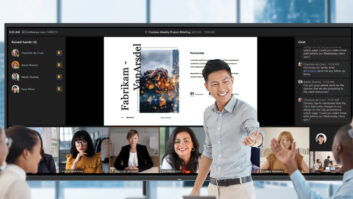
Tell me a bit about your background in the AV industry.
Prior to founding Exterity, I served as the European marketing director at remote access and network technology company Shiva at the point where it was acquired by Intel, and as product manager with IndigoVision, an early pioneer in Internet Protocol video technologies. These roles gave me a holistic understanding of the video and technology industry and prepared me for Exterity.
You co-founded Exterity in 2001. What are the biggest changes you’ve seen in the AV sector since then?
I founded Exterity in 2001 with Mike Allan, our chief technology officer to this day – the year the dotcom bubble burst. Mike and I had worked in the same company two years earlier; he was running the engineering department while I was a product marketing manager. The downturn in the tech market at that time acted as a prompt to Mike and I to look at the potential of creating our own business. It was a tough decision at the time but it has proved to be incredibly rewarding as we’ve grown our business into a global provider of AV technology.
At that time, many organisations were relying on large scale RF cabling systems to distribute TV content around buildings – something we believed to be an expensive, inflexible and unsustainable solution. We recognised that video streaming over Internet Protocol Television (IPTV) had the potential to be the future of TV and video content distribution around buildings. At the time, it was radical and about five years ahead of the large-scale adoption of the technology, but we took the risk and Exterity was born later that year. Today, Exterity has customers and partners in 50 countries, 120 staff in nine offices around the world, and hundreds of thousands of screens across the world that have been powered by our technology.
Over the past 18 years, possibly the biggest surprise was just how fast IP has risen from challenger to the dominant technology for AV content distribution. Another change was how much the AV industry has shifted from hardware to software solutions, helping to speed up innovation and giving the opportunity for easier integration between systems.
Your focus is on IPTV and digital signage solutions. In simple terms, how would you explain what IPTV is?
IPTV describes the distribution of video content over an IP network. In the professional AV world this is typically the same network used by organisations to carry their other business IT services such as email and telephone calls. The content can include terrestrial and satellite television and radio, Video on Demand (VoD) and in-house produced video. The IP network can reach a wide range of devices including TVs, laptops, tablets, video walls and digital signage screens, to name but a few. It enables the easy addition of new TV and video sources for delivery to users anywhere there is a network connection and does so without video degradation, making it is quicker and less expensive to extend a system. The technology can also integrate security to protect premium content and a lower management overhead as it uses the same type of infrastructure as other IP traffic.
What benefits does digital signage offer in a corporate environment?
More and more businesses are realising the benefits of using digital signage to streamline communications and engage both internal and external audiences. Digital signage is used to deliver information, alerts, advertisements and entertainment through a combination of video, graphics and text messaging to offer a powerful medium that can reach an audience in the most compelling way. In a corporate environment, some of the key use cases include the ability to communicate live news, video and tailored information simultaneously within signage screens. This can be used to reinforce communications with branded, engaging messaging, while simultaneously providing informative, educational or entertaining video content. Digital signage technology enables a company to turn any TV screen, SmartTV or large-format display into a digital signage delivery point, while management software is often as simple as a word processor to operate and allows users to simply create and schedule content or assign creation, editing and publishing control of specific screens or screen areas to certain authorised users.
For any business considering investing in a digital signage system, taking time to consider how the signage will be used will help define the scale and scope of the installation, including screen location and accompanying messages, e.g., public areas addressing visitor vs internal staff communication in breakout areas, factory floors or cafeterias, and who will be involved in creating content. If the signage requires live news feeds, then further consideration should be given to the IPTV system with which it needs to integrate.
You’re also active in the hospitality, education and stadium and venues sectors. What trends are you seeing here currently?
AV technologies are growing rapidly within the hospitality sector as tech-savvy travellers demand entertainment experiences that match their home set-up, and major hotel chains are investing more in sophisticated in-room technologies, like our customer, Six Senses Zighy Bay. In-room systems now provide extensive live and on-demand video entertainment alongside multilingual access to revenue-generating services. More innovative hotels are turning the in-room screen into a single platform for a range of communications and services, including mailbox messaging; room service food and beverage ordering; spa, restaurant or excursion reservations; taxi booking; laundry services; baggage pick-up and more.
In the education sector, we are seeing an increase in demand for cutting-edge video-based technologies to meet the needs of modern students who are accustomed to constant connectivity. One of the big trends we are seeing in education is on-the-go learning. Students lead busy lives and are often juggling their studies, part-time jobs, extra-curricular activities so they don’t want to be tethered to the lecture room. AV technologies mean that educational institutions can now offer recorded and live streamed learning material on any device, any network, anywhere and at any time. As a result, mobile devices have become an extension of the lecture theatre, making higher education accessible for all, including part-time workers and students with families.
In the stadiums and venues world we are seeing a growing number of organisations recognise that financial success is more than just what happens on the pitch. Increasingly, fan engagement within the facility is a critical part of the overall experience and return on investment. For example, ParisLongchamp, the world-famous horse racing track is using both IP-based video distribution and digital signage to provide a wealth of branding, advertising and operational benefits and opportunities that are difficult to replicate via traditional means. At the venue entrance, IPTV-driven screens are often used to reinforce branding, engage with arriving supporters and create a buzz. In central atriums, displays provide guests with information about seating, restroom location and other facilities. Increasingly, these signs are dynamically managed to cater for unique events or special offers as well as for contingencies such as seating section changes or restroom facility closures. This is a trend we are seeing being replicated by venues and stadiums all over the world.
Outside of work, how do you like to spend your time?
My father was a builder and made sure that we were all very practical, so if I need to relax, I take on a DIY job at home. Sounds great, but my wife complains that I take twice as long as a qualified tradesperson to get jobs done. Still, it is very satisfying to see a job finished and hopefully making a difference.
Finally, tell us something about yourself that might surprise people
I tend to work a little later than most in the office. This gives me the chance to play cheesy 80s tunes after 5:30pm and sing along in my office. Sadly, I have mis-timed this a few times and have ended up embarrassingly singing out of tune to half the office!







